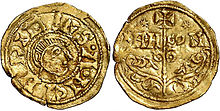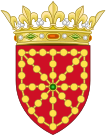Sancho Ramírez
| Sancho Ramírez | |
|---|---|
 Gold mancuso of Sancho | |
| King of Aragon | |
| Tenure | 1063–1094 |
| Predecessor | Ramiro I |
| Successor | Peter I |
| King of Pamplona | |
| Tenure | 1076–1094 |
| Predecessor | Sancho IV |
| Successor | Peter I |
| Born | c. 1042 |
| Died | 1094 |
| Spouse | Isabella of Urgell Felicia of Roucy |
| Issue | Peter Fernando Alfonso Ramiro |
| House | House of Jiménez |
| Father | Ramiro I |
| Mother | Ermesinda of Bigorre |
| Religion | Catholicism |
Sancho Ramírez (c. 1042 – 4 June 1094) was King of Aragon from 1063 until 1094 and King of Pamplona from 1076 under the name of Sancho V (Basque: Antso V.a Ramirez). He was the eldest son of Ramiro I and Ermesinda of Bigorre. His father was the first king of Aragon and an illegitimate son of Sancho III of Pamplona. He inherited the Aragonese crown from his father in 1063.[1] Sancho Ramírez was chosen king of Pamplona by Navarrese noblemen after Sancho IV was murdered by his siblings.
Biography[edit]
Sancho Ramírez succeeded his father as second King of Aragon in 1063.[1] Between 1067 and 1068, the War of the Three Sanchos involved him in a conflict with his first cousins, both also named Sancho: Sancho IV the king of Navarre and Sancho II the king of Castile, respectively. The Castilian Sancho was trying to retake Bureba and Alta Rioja, which his father had given away to the king of Navarre and failed to retake. The Navarrese Sancho begged the aid of the Aragonese Sancho to defend his kingdom. Sancho of Castile defeated the two cousins and retook both Bureba and Alta Rioja, as well as Álava.
Sancho Ramírez followed his father's practice, not using the royal title early in his reign even though his state had become fully independent. This changed in 1076, when Sancho IV of Navarre was murdered by his own siblings, thus prompting a succession crisis in this neighboring kingdom that represented Aragon's nominal overlord.[2] At first, the murdered king's young son, García, who had fled to Castile, was recognized as titular king by Alfonso VI, while Sancho Ramírez recruited to his side noblemen of Navarre who resented their kingdom falling under Alfonso's influence. The crisis was resolved by partition. Sancho Ramírez was elected King of Navarre, while he ceded previously contested western provinces of the kingdom to Alfonso. From this time, Sancho referred to himself as king not only of Navarre but also Aragon.
Sancho conquered Barbastro in 1064, Graus in 1083, and Monzón in 1089. He was defeated by El Cid, who was raiding his lands and those of his Muslim allies, at the Battle of Morella, probably in 1084.[3] He perished in 1094 at the battle of Huesca, supposedly from an arrow while inspecting the walls of the Muslim stronghold.
Sancho contracted his first marriage in c. 1065, to Isabella (died c. 1071), daughter of Count Armengol III of Urgel. They were divorced 1071. His second marriage, in 1076, was with Felicia (died 3 May 1123), daughter of Hilduin IV, Count of Montdidier. A third marriage—to Philippa of Toulouse—is sometimes given,[4] but contemporary evidence records him as still married to Felicia at the time of his death.[5] He was father of four sons: by Isabella, he had Peter, his successor; by Felicia he had Ferdinand, who was alive in 1086 but died within the next decade, Alfonso, who succeeded Peter, and Ramiro, who succeeded Alfonso.[6]
Marriage and family[edit]
Sancho Ramírez married Isabella of Urgell, daughter of Ermengol III, Count of Urgell around the year 1062. They had one known child:
- Peter (c. 1068 – 1104), known as "the Catholic", who ruled as King of Aragon and Pamplona from 1094 until 1104. Peter married Agnes of Aquitaine.
Sancho Ramírez remarried around 1071 with Felicia of Roucy, daughter of Hilduin IV, Count of Montdidier.[7] They had three children:
- Fernando Sánchez (1071 – 1094)[8]
- Alfonso Sánchez (c. 1073 – 1134), known as "the Battler", King of Aragon and Pamplona from 1104 until 1134. He married Urraca of León, Queen of León, Castile and Galicia. Their marriage was annulled in 1112.
- Ramiro Sánchez (1086 – 1157), known as "the Monk", King of Aragon between 1134 and 1157, and married to Agnes of Aquitaine in her second marriage after Viscount of Thouars, Aimery V.
Ancestry[edit]
This section does not cite any sources. (June 2019) (Learn how and when to remove this template message) |
| Ancestors of Sancho Ramírez | |||||||||||||||||||||||||||||||||||||||||||||||||||||||||||||||||||||||||||||||||||||||||||||||||||||||||||||||||||||||||||||||||||||||||||||||||||||||||||||||||||||||||||||||||||||||||||||||||||||||||||||||||||||||||||||||||||||||||||||||||||||||||||||||||||||||||
|---|---|---|---|---|---|---|---|---|---|---|---|---|---|---|---|---|---|---|---|---|---|---|---|---|---|---|---|---|---|---|---|---|---|---|---|---|---|---|---|---|---|---|---|---|---|---|---|---|---|---|---|---|---|---|---|---|---|---|---|---|---|---|---|---|---|---|---|---|---|---|---|---|---|---|---|---|---|---|---|---|---|---|---|---|---|---|---|---|---|---|---|---|---|---|---|---|---|---|---|---|---|---|---|---|---|---|---|---|---|---|---|---|---|---|---|---|---|---|---|---|---|---|---|---|---|---|---|---|---|---|---|---|---|---|---|---|---|---|---|---|---|---|---|---|---|---|---|---|---|---|---|---|---|---|---|---|---|---|---|---|---|---|---|---|---|---|---|---|---|---|---|---|---|---|---|---|---|---|---|---|---|---|---|---|---|---|---|---|---|---|---|---|---|---|---|---|---|---|---|---|---|---|---|---|---|---|---|---|---|---|---|---|---|---|---|---|---|---|---|---|---|---|---|---|---|---|---|---|---|---|---|---|---|---|---|---|---|---|---|---|---|---|---|---|---|---|---|---|---|---|---|---|---|---|---|---|---|---|---|---|---|---|---|---|---|
| |||||||||||||||||||||||||||||||||||||||||||||||||||||||||||||||||||||||||||||||||||||||||||||||||||||||||||||||||||||||||||||||||||||||||||||||||||||||||||||||||||||||||||||||||||||||||||||||||||||||||||||||||||||||||||||||||||||||||||||||||||||||||||||||||||||||||
Notes[edit]
- ^ a b Vicente Salas Merino, La Genealogía de los Reyes de España, (Visionnet, 2007), 220.
- ^ Simon Barton, The Aristocracy in Twelfth-Century León and Castile, (Cambridge University Press, 1997), 9.
- ^ Bernard F. Reilly, The Contest of Christian and Muslim Spain, 1031-1157, (Blackwell, 1995), 109.
- ^ Richard, Alfred, Histoire de Comtes de Poitou, 778–1204
- ^ Szabolcs de VAJAY, "Ramire II le Moine, roi d'Aragon et Agnes de Poitou dans l'histoire et la légende", in Mélanges offerts à René Crozet, 2 vol, Poitiers, 1966, vol 2, p 727-750; and Ruth E Harvey, "The wives of the first troubadour Duke William IX of Aquitaine", in Journal of Medieval History, vol 19, 1993, p 315. Harvey states that, contrary to prior assumptions, William IX was certainly Philippa of Toulouse's only husband. Vajay states that the marriage to an unnamed king of Aragon reported by a non-contemporary chronicler is imaginary, even though it has appeared broadly in modern histories, and likewise he cites J de Salarrullana de Dios, Documentos correspondientes al reinado de Sancho Ramirez, Saragossa, 1907, vol I, nr 51, p 204-207 to document that Felicia was clearly still married to Sancho months before his death, making the marriage to Philippa several years earlier, as reported in several modern popular biographies of her granddaughter, completely unsupportable.
- ^ An origin legend of the house of Ayala gives him another son, Vela or Velasgutto de Ayala, by a Barcelonan lady. An alternative version makes the father Ramiro I. This story is without solid foundation, and may represent a confused memory of a feudal relationship with Sancho Ramírez of Viguera and his Vela clan vassals.
- ^ Les généalogies entre l'histoire et la politique: la fierté d'être Capétien, en France, au Moyen Age, Bernard Guenée, Annales. Histoire, Sciences Sociales, 33e Année, No. 3 (May - Jun., 1978), 471.
- ^ Lema Pueyo (2008:48)
- ^ The Crónica de Aragón, produced in 1499, names her Doña Caya, but she is named Sancha in a contemporary donation. Ballesteros y Beretta, v. 2, pp. 319–320.
Bibliography[edit]
- Buesa Conde, Domingo (1996). Sancho Ramírez, rey de aragoneses y pamploneses (1064–1094). Zaragoza: Caja de Ahorros y Monte de Piedad de Zaragoza, Aragón y Rioja.CS1 maint: ref=harv (link)
- Canellas López, Ángel (1993). Colección diplomática de Sancho Ramírez. Zaragoza: Real Sociedad Económica Aragonesa de Amigos del País.CS1 maint: ref=harv (link)
- Lapeña Paúl, Ana Isabel (2004). Sancho Ramírez, rey de Aragón (¿1064?–1094) y rey de Navarra (1076–1094). Gijón: Ediciones Trea.CS1 maint: ref=harv (link)
- Nelson, Lynn H. (1978). "The Foundation of Jaca (1076): Urban Growth in Early Aragon". Speculum. 53 (4): 688–708.CS1 maint: ref=harv (link)
- Reilly, Bernard F. (1989). The Kingdom of León-Castilla under King Alfonso VI, 1065–1109. Princeton University Press. ISBN 9788487103032.CS1 maint: ref=harv (link)
- Reilly, Bernard F. (1992). The Contest of Christian and Muslim Spain, 1031–1157. Wiley.CS1 maint: ref=harv (link)
- Reilly, Bernard F. (1993). The Medieval Spains. Cambridge University Press.CS1 maint: ref=harv (link)
- Sarasa Sánchez, Esteban, ed. (1994). Sancho Ramírez, rey de Aragón, y su tiempo (1064–1094). Huesca: Instituto de Estudios Altoaragoneses.CS1 maint: ref=harv (link)
- Smith, Damian (1996). "Sancho Ramírez and the Roman Rite". Studies in Church History. 32: 95–105.CS1 maint: ref=harv (link)
- Ubieto Arteta, Antonio (1948). "Homenaje de Aragón a Castilla por el condado de Navarra". Estudios de Edad Media de la Corona de Aragón. 3: 7–28.CS1 maint: ref=harv (link)
External source[edit]
Sancho Ramírez Born: c. 1042 Died: 4 Juni 1094 | ||
| Preceded by Ramiro I | King of Aragon 1063–1094 | Succeeded by Peter I |
| Preceded by Sancho IV | King of Navarre 1076–1094 | |



No comments:
Post a Comment